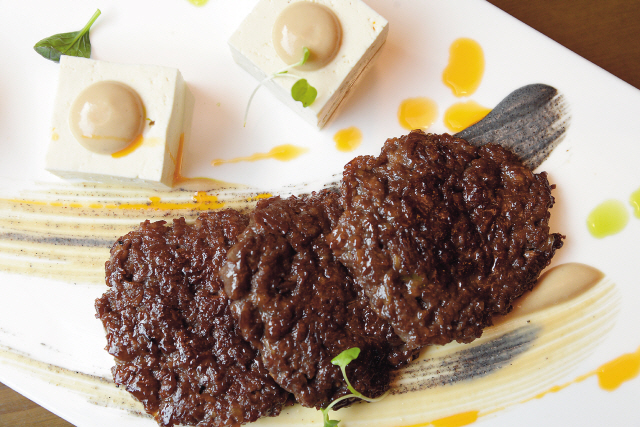Korean restaurant makes house-made tofu focus of modern menu
At Dudukansang ― a restaurant located in Gyeonggi Province near Pangyo that opened a year-and-a-half ago ― tofu and other soybean-based dishes are the focus of an inventive and health-oriented menu.
Owner-chef Lee Song-mo parlays expertise built up in the realm of Western cuisine to give snowy, creamy, house-made bean curd a pleasant and unexpected “oomph,” draping cubes of it over a spicy, tomato-infused mussel soup and using it to make dairy-free ice cream, where tart omija and lemon juice give the dessert its tasty kick.
At Dudukansang ― a restaurant located in Gyeonggi Province near Pangyo that opened a year-and-a-half ago ― tofu and other soybean-based dishes are the focus of an inventive and health-oriented menu.
Owner-chef Lee Song-mo parlays expertise built up in the realm of Western cuisine to give snowy, creamy, house-made bean curd a pleasant and unexpected “oomph,” draping cubes of it over a spicy, tomato-infused mussel soup and using it to make dairy-free ice cream, where tart omija and lemon juice give the dessert its tasty kick.

Tofu is also paired with juicy, char-grilled bulgogi patties to great effect. Dollops of roasted garlic-and-bean curd sauce adorn cubes of smooth, silken tofu alongside aged kimchi.
The sweetness of the bulgogi goes well with the mild tofu, while the kimchi adds a salty-sour note at the end.
Not every dish is a modern take on a classic. Lee also sends a respectful nod to tradition with a savory biji (bean curd dregs) stew.
“It is still authentic Korean cuisine,” the 32-year-old owner-chef said, explaining that Korean flavors form the backbone of the menu.
“Our tofu is made almost every day,” he said. “We stick to an old school way of making it by using seawater as a coagulant and perilla oil as an anti-foaming agent.”
Customers can buy fresh blocks of tofu to go but since it is preservative-free, Lee recommends consuming it the day of or storing it in the refrigerator for no longer than one to two days.
Since the tofu is made from scratch, Lee and crew are given free reign to experiment with all the components behind the Korean household staple, including soymilk, which is used as the base for a thick mountain yam porridge.
What prompted Lee to devote himself to the art of tofu and its cousins?
“On the Korean table, soybeans are present everywhere, in the soy sauce, doenjang and gochujang we eat,” he explained. “Also tofu played an important role in traditional Korean cuisine as a source of protein.”
Tofu is an age-old part of the Korean diet, having entered the nation from China over 1,000 years ago.
While it can be enjoyed in a variety of dishes, fresh tofu, like that by Dudukansang, is excellent slightly steamed and seasoned, soft piece by soft piece, with some soy sauce flecked with garlic, chili pepper flakes, green onions and vinegar, or with some kimchi.
By Jean Oh (oh_jean@heraldcorp.com)
Dudukansang;
87-2 Gumto-dong, Sujeong-gu, Seongnam-si, Gyeonggi Province; (031) 8017-2213; open 11:30 a.m. to 9 p.m. daily; prix fixe meals cost 18,000 won to 23,000 won, one block of tofu costs 5,000 won
-
Articles by Korea Herald







![[Weekender] How DDP emerged as an icon of Seoul](http://res.heraldm.com/phpwas/restmb_idxmake.php?idx=644&simg=/content/image/2024/04/25/20240425050915_0.jpg&u=)
![[KH Explains] No more 'Michael' at Kakao Games](http://res.heraldm.com/phpwas/restmb_idxmake.php?idx=644&simg=/content/image/2024/04/28/20240428050183_0.jpg&u=20240428180321)









![[Herald Interview] Mistakes turn into blessings in street performance, director says](http://res.heraldm.com/phpwas/restmb_idxmake.php?idx=652&simg=/content/image/2024/04/28/20240428050150_0.jpg&u=20240428174656)
